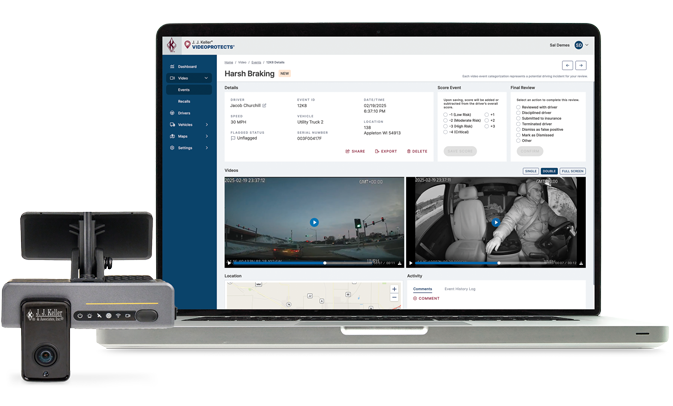Sr. Transportation Management Editor — J. J. Keller & Associates, Inc.
5 Essentials for an Effective Dash Cam Policy
An effective dash cam policy improves safety, accountability, and recognition, while protecting driver privacy and complying with laws. Here are five essentials for creating one for your company.
Published On: 09/26/2025


Written by:
Mark Schedler
Companies need clear, fair, and legally sound dash cam policies. An effective policy improves safety, accountability, and recognition, while protecting driver privacy and complying with laws. Here are five essentials for creating one for your company.
1. Clearly state the purpose
Explain why dash cams are used:
- To determine what happened in a crash,
- To coach drivers,
- To recognize good driving, and
- To monitor compliance with traffic laws.
2. Protect driver privacy
Include written privacy protections and explain how footage will be used.
Key points:
- Driver-facing cameras: Record drivers in-cab only to check for legal compliance (e.g., seat belts, phone use, fatigue/distraction). Be transparent about what’s
- recorded and when.
- Recording limits: Record inside the vehicle only during on-duty time.
- Video use: Use clips for coaching or legal defense. Get a driver’s consent for any other use.
- Access control: Limit the personnel who can view footage.
- Retention: Keep footage only as long as needed and in accordance with the company data retention policy.
- Secure storage: Use encrypted systems to prevent breaches.
- Audio recording: Avoid activating audio recording unless necessary, where legally allowed, and with proper consent.
- Live remote viewing: Allow only in emergencies.
3. Ensure legal compliance
Dash cams are allowed in work vehicles, but policies must follow state and federal laws.
Considerations:
- Recording laws: Some states (e.g., California) limit how much footage can be stored—usually only a few seconds before/after an event.
- Facility restrictions: Some places ban recording. Drivers must follow these rules or contact safety if unsure.
- Biometric data: If using facial recognition, eye-tracking, fingerprints, or other biometric data, follow laws like Illinois’ Biometric Information Privacy Act (BIPA) which requires:
- Get written consent;
- Explain what’s collected, how it’s used, and retention timelines; and
- Store data securely and delete it as required.
- Audio recording: Not recommended due to privacy concerns, limited usefulness, and legal risks. Many states require prior consent of all parties. A violation of audio recording laws can result in up to a felony conviction, depending on the state.
- Camera placement: Must not block the driver’s view whether interstate or intrastate. Federal rules for windshield-mounted cameras with respect to the area swept by the wipers:
- No more than 8.5" below the top edge, or
- No more than 7" above the bottom edge. Check state-specific rules for intrastate carriers.
4. Train and communicate
Educate drivers on:
- How the system works,
- What triggers recordings, and
- How footage is used.
Communicate changes to the policy to all parties and document training on policy revisions.
5. Review and update regularly
Dash cam technology and laws change. Review the policy at least yearly and get feedback from drivers, back-office users, and legal experts.
Conclusion
A strong dash cam policy balances safety, accountability, driver rights, and recognition. Transparency and legal compliance help build trust while improving fleet performance.

VideoProtects® Fleet Camera System
J. J. Keller’s VideoProtects® Fleet Camera System provides a full suite of safety features for improving driver safety and minimizing your fleet’s risk. Because it’s platform-independent, you can use it for any type of vehicles and with any fleet management software.
You may also enjoy the following articles:
Sign up for our newsletter!
We'll help you stay on top of regulations, best practices, and fleet industry news. Sign up to receive a monthly email notification with links to our most recent blog articles, free resources, and event invites.